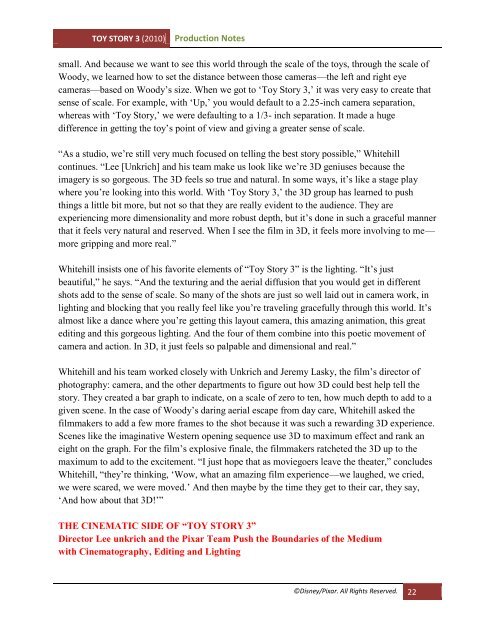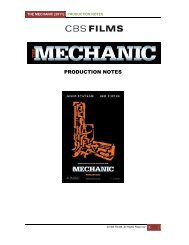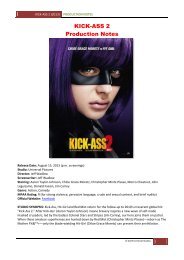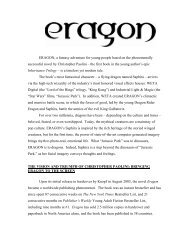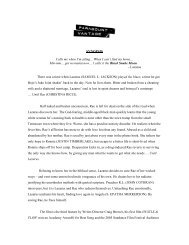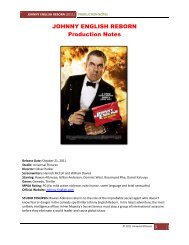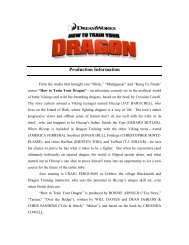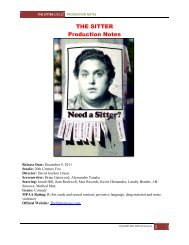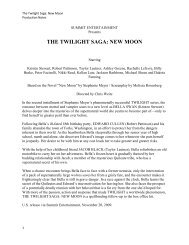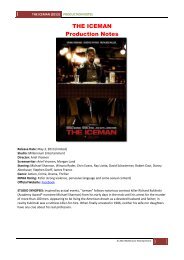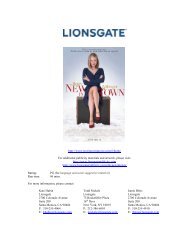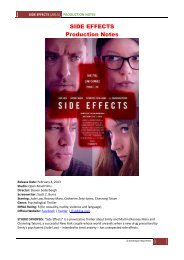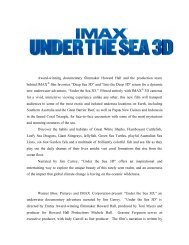Create successful ePaper yourself
Turn your PDF publications into a flip-book with our unique Google optimized e-Paper software.
<strong>TOY</strong> <strong>STORY</strong> 3 (2010)Production Notessmall. And because we want to see this world through the scale of the toys, through the scale ofWoody, we learned how to set the distance between those cameras—the left and right eyecameras—based on Woody‘s size. When we got to ‗Toy Story 3,‘ it was very easy to create thatsense of scale. For example, with ‗Up,‘ you would default to a 2.25-inch camera separation,whereas with ‗Toy Story,‘ we were defaulting to a 1/3- inch separation. It made a hugedifference in getting the toy‘s point of view and giving a greater sense of scale.―As a studio, we‘re still very much focused on telling the best story possible,‖ Whitehillcontinues. ―Lee [Unkrich] and his team make us look like we‘re 3D geniuses because theimagery is so gorgeous. The 3D feels so true and natural. In some ways, it‘s like a stage playwhere you‘re looking into this world. With ‗Toy Story 3,‘ the 3D group has learned to pushthings a little bit more, but not so that they are really evident to the audience. They areexperiencing more dimensionality and more robust depth, but it‘s done in such a graceful mannerthat it feels very natural and reserved. When I see the film in 3D, it feels more involving to me—more gripping and more real.‖Whitehill insists one of his favorite elements of ―Toy Story 3‖ is the lighting. ―It‘s justbeautiful,‖ he says. ―And the texturing and the aerial diffusion that you would get in differentshots add to the sense of scale. So many of the shots are just so well laid out in camera work, inlighting and blocking that you really feel like you‘re traveling gracefully through this world. It‘salmost like a dance where you‘re getting this layout camera, this amazing animation, this greatediting and this gorgeous lighting. And the four of them combine into this poetic movement ofcamera and action. In 3D, it just feels so palpable and dimensional and real.‖Whitehill and his team worked closely with Unkrich and Jeremy Lasky, the film‘s director ofphotography: camera, and the other departments to figure out how 3D could best help tell thestory. They created a bar graph to indicate, on a scale of zero to ten, how much depth to add to agiven scene. In the case of Woody‘s daring aerial escape from day care, Whitehill asked thefilmmakers to add a few more frames to the shot because it was such a rewarding 3D experience.Scenes like the imaginative Western opening sequence use 3D to maximum effect and rank aneight on the graph. For the film‘s explosive finale, the filmmakers ratcheted the 3D up to themaximum to add to the excitement. ―I just hope that as moviegoers leave the theater,‖ concludesWhitehill, ―they‘re thinking, ‗Wow, what an amazing film experience—we laughed, we cried,we were scared, we were moved.‘ And then maybe by the time they get to their car, they say,‗And how about that 3D!‘‖THE CINEMATIC SIDE OF “<strong>TOY</strong> <strong>STORY</strong> 3”Director Lee unkrich and the Pixar Team Push the Boundaries of the Mediumwith Cinematography, Editing and Lighting©Disney/Pixar. All Rights Reserved. 22


